#science communication
Text
Okay, I know people as a general rule tend to not care about invertebrates as much as cute, fuzzy mammals, but this is a must-read if you care about animal welfare. The short version is that horseshoe crab blood has been used for decades in medicine as a way to test whether something is truly sterile; the blood clots in the presence of bacteria. Since then millions of horseshoe crabs have been captured and drained of blood, even though a synthetic alternative was developed a few years ago.
They go through a pretty brutal experience in the process. They're caught by fishermen who often throw them by their tails into a pile in the open air, and they're then trucked to a bleeding facility where they're strapped down and their blood is removed with needles jabbed directly into their hearts. Over half their blood may be taken, after which they're supposed to be returned to the ocean. However, it's likely many of them never make it back, instead turned into fish bait and sold by the same fishermen who caught them in the first place.
Apart from the fact that this is a horrific thing to put any animal through, the attrition due to fatalities has put a serious dent in horseshoe crab numbers. This is compounded by massive habitat loss, pollution, and the capture of horseshoe crabs as food, particularly as the females of one species are considered a delicacy. And other animals that rely on horseshoe crabs are suffering, too. The American rufa subspecies of the red knot, a medium-sized shorebird, is critically endangered as the horseshoe crab eggs it must have in order to successfully complete migration have become increasingly scarce, and it is likely the bird will become extinct if trends continue.
While there are guidelines for medical horseshoe crab harvest, they're considered optional. The few laws that exist are poorly enforced. Short of a complete ban on horseshoe crab blood in favor of the synthetic alternative, these animals are in very real danger of going extinct after a history spanning over 400 million years on this planet.
Thankfully, this article is not the first to bring forth the issues surrounding horseshoe crab harvest. Here are a few resources for further information and action (US based, though horseshoe crabs are threatened throughout their entire range):
Horseshoe Crab Conservation Network - https://horseshoecrab.org/conservation/
Wetlands Institute - https://wetlandsinstitute.org/conservation/horseshoe-crab-conservation/
Horseshoe Crab Recovery Coalition - https://hscrabrecovery.org/
#animal welfare#animal cruelty#cw animal cruelty#animal suffering#horseshoe crabs#invertebrates#wildlife#animals#environment#conservation#endangered species#extinction#nature#medicine#science#scicomm#science communication
8K notes
·
View notes
Text

Alright people. I need your help. Enrollment for Skype a scientist this semester has been -fine- but we can do better. We have so many scientists who want to speak with classrooms! Will you tell a teacher you know about our program 🥺 please?
Send them to skypeascientist.com/sign-up
2K notes
·
View notes
Text
if theres anything ive learned about science communication both online and offline its that people love unusually large or small versions of a creature. nothing really reaches across the barriers of age, education, or language like that does. if it has another interesting factor that seems mildly upsetting or surprising but not offensive to broad human cultural norms, that is a plus but its not required because even then for a single moment everyone is like damn, yeah, thats pretty big or small, and then even if they remember nothing else they might remember that the creatures are coming in Sizes. you know
#this post sounds like its about the titan arum but its actually about the double coconut at my workplace that looks like a butt#seedposting#scicomm#science communication
1K notes
·
View notes
Text

🚨 A team of scientists, led by Phil Morin of NOAA, have published a new paper formally proposing two “new” species of killer whale: Bigg’s killer whales (Orcinus rectipinna) and resident killer whales (Orcinus ater).🚨
More than fifty years ago, researchers began studying the killer whales found off the west coast of North America. One keen-eyed scientist, Dr. Michael Bigg, noticed that there appeared to be two kinds of killer whales: a smaller, more gregarious form that fed on fish and a larger, stealthier type that fed on marine mammals. He and his colleagues dubbed the fish-eaters “resident” killer whales and the mammal-eaters “transient” killer whales (who were later renamed Bigg’s killer whales in his honor).
Two female Bigg’s killer whales in Washington (top) and a male and female resident killer whale in Alaska (bottom)
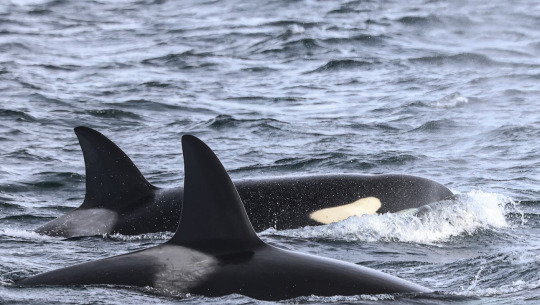

Many decades later, scientists have been hard at work trying to resolve whether or not these two forms are different species. It is not an easy task. This requires a thorough investigation into many factors, including evolutionary history, genetics, morphology, ecology, and behavior. In this paper, the researchers lay out all of the evidence and conclude that these two forms warrant elevation to species status.
As newly proposed species, both need new scientific names. There have been numerous killer whale species proposed and described in the past by other naturalists and researchers, including those in the North Pacific. Unfortunately, there are no type specimens— individual specimens upon which the first descriptions of a species are based—available for killer whales previously described from the North Pacific, so the researchers were left to examine drawings and illustrations of killer whales in the North Pacific in the late 1800s by Scammon and Cope.
The authors propose “Orcinus rectipinnus” for Bigg’s killer whales and “Orcinus ater” for resident killer whales. “Rectipinnus” presumably refers to tall dorsal fins, and “ater” means “black” or “dark” in Latin. Of note is the fact that a female killer whale from California originally examined and described by Scammon as “Orcinus rectipinnus” had seals in her stomach, suggesting she was a Bigg’s killer whale.
In addition, the authors note they are consulting with Indigenous tribes for a new common name for resident killer whales.
What’s next? In marine mammal biology, proposed taxonomic changes are reviewed by the Society for Marine Mammalogy’s taxonomy committee. If accepted, these species revisions become “official.” This has been an eagerly awaited paper by many in the field of killer whale biology and it is a great accomplishment, made possible by decades of research by scientists around the world.
A big thank you to lead author Phil Morin for letting me preview the manuscript and for answering my numerous questions in preparation for this post!
Read the paper here!
#killer whale#orca#science communication#marine biology#marine mammal#cetaceans#marine mammals#orcas#whales
541 notes
·
View notes
Text
Woman Who Can Smell Parkinson’s Helps Develop Test
Joy Milne, 72, from Perth, Scotland, has a hyper-sensitive sense of smell, allowing her to be able to smell Parkinson’s disease, which progressively damages parts of the brain over many years.
She discovered her unusual ability when her late husband, Les, developed a different odour when he was 33. She described it as a ‘musky aroma’. That was 12 years before he was diagnosed with Parkinson’s. Les, who was a doctor, was determined to research the link between odour and Parkinson’s, and contacted Dr Tilo Kunath at the University of Edinburgh, who paired up with Professor Perdita Barran to begin the research. They determined that the reasons for a change in the scent of a person suffering the disease is due to a chemical change of the skin oil (sebum).
In the preliminary sessions, Milne was asked to smell T-shirts worn by people who had Parkinson’s and those who did not. She successfully identified all of the Parkinson’s patients, but told researchers that a member of the control group, a non-Parkinson’s patient, did smell like the disease. 8 months later, they were diagnosed with the disease.
Now, a team of researchers at the University of Manchester have developed a simple test involving a cotton bud swiped down the back of the neck that can identify those with Parkinson’s. The molecules on the cotton bud can be examined using mass spectrometry, which helps the diagnosis. This is a huge leap forward, as there is no definitive test for Parkinson’s, and a diagnosis is based on symptoms and medical history. Currently, there are no cures for Parkinson’s, but an early diagnosis can help begin the treatment early, lessening the speed of the deterioration.
Milne says she can sometimes smell that a person has Parkinson’s when walking down the street, but has been told by medical ethicists that she cannot tell them. She is continuing to work with scientists to see if she can smell other diseases, like cancer or TB, and hopes that one day her talent can be considered normal diagnosis.
Source: the Guardian, written by PA Media
#science#science communication#scicomm#stem#science education#biology#health#medical science#parkinson's disease
9K notes
·
View notes
Text
really hate when mainstream astronomy journalism does this
https://www.cbsnews.com/news/saturns-rings-disappear-from-view-march-23-2025-nasa-expert-says/

this entire article feels like it's written from the perspective of a space skeptic getting confirmation from nasa that it's real
even in the title, they say "nasa says" like the new york times says "palestinians say"
the entire article would come off so much better if any of this (correct!) info was said with like 1% confidence in it, it legit feels like they intentionally included the "nasa says" parts to feed into pseudoscience. it comes off so horribly to anyone with some knowledge of astronomy
"Saturn's rings will seemingly disappear from view in 2025" the addition of "seemingly" here is totally unnecessary and only adds more apparent skepticism from the author (and by extension, the reader)
"Saturn won't actually lose its rings in 2025, but they will go edge-on, meaning they will be essentially invisible to earthlings, NASA confirmed to CBS News." correct info, but adding "nasa confirmed" instantly makes us think this was just a random theory before nasa told them that it's true, when it is not by any means a random theory
the article gets noticeably more scientific as it goes on, which makes it even worse that they put the most clickbaity skeptical stuff in the headline and opening paragraphs
it perpetuates the weird idea that info about astronomy in particular is like, sacred to people that are in the field, and can't be reported on without contacting 5 people at nasa to confirm it in your article
it's so wrong because most stuff about basic astronomy is totally definitive and can be predicted 100% of the time using basic math, we shouldn't need top scientists at nasa to confirm that there's a full moon coming up on the day the moon will be full (something i have actually seen happen!)
and overall, it also perpetuates the general stigma on astronomy as somehow harder or more complex than most other fields, something that average person can't get into and that's reserved for genius level intellects
not great stuff cbs!
#astronomy#space#night sky#news#astronomy thoughts#space thoughts#science communication#public outreach
340 notes
·
View notes
Text
Alright here's the deal:
no, it doesn't really matter if cartoons misrepresent dinosaurs. Almost like most people don't really spend their time critiquing them (I certainly don't, unless someone asks me to, and then it's cause they asked)
The representation of dinosaurs and the deep past actually does matter, because it completely disproves the founding myths of society that have lead to climate change and environmental destruction. I can explain why, but I'm trying to be brief.
If you really think that paleontologists who use social media - ie, all of them, because unfortunately online science communication is now a mandatory part of being a scientist - want to spend all their time critiquing dinosaur designs, you are very, very, very wrong
Thinking that living things matter more than dead things is so illogical (everything living one day becomes dead. the past matters) that it sounds like a twelve year old whining about studying for their bar mitzvah.
Misinformation of any kind is bad and you should be against it. Acting like some is okay while others aren't is just... picking and choosing favorites. Way to be consistent.
The end.
337 notes
·
View notes
Text
Minimocursor
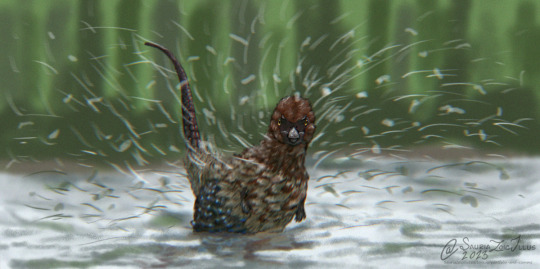
a new dinosaur was described today from Thailand!
Meet Minimocursor phunoiensis, described by Manitkoon et al., (2023), congrats on the description!
#paleoart#digital art#digital illustration#palaeoart#paleontology#artists on tumblr#digital artwork#sciart#dinosaur#scicomm#science communication#new dinosaur#id in alt text#alt text
337 notes
·
View notes
Text
About Nucear Permanent Disposal Sites

So, a couple of days ago someone commented under my one blog about nuclear energy what boiled down to: "But what about the waste? We need to take responsibility for the next thousands of years of humanity!" And yes, that is very much the favorite argument for the anti-nuclear lobby... and it is pretty much based on the science of the 1980s.
What a lot of people do not understand is:
How little nuclear waste we actually have.
How little of that waste is actually the highly radiating stuff.
How well we can contain this stuff.
That we actually have figured out a solution for permanent disposal.

First need about nuclear waste you have to understand that most of it is not that dangerous. Most of the waste we get out of the nuclear facilities is actually just stuff that was around the radiation and got slightly radiated. 90% of all nuclear waste is stuff like items that just happened to be within the nuclear facilities for a long while. Tools, wortk clothing and so on. This stuff radiates, yes, but it is technically not dangerous levels AND it will stop doing so within 100 years max. We literally do not need to worry about it. Those yellow barrels you will keep seeing in old media that somehow end up mutating people? Yeah, those are used for this kind of waste. And to be quite frank, we are super extra that we store this either way. Because we have waste from other types of facilities (like coal power, but also from places like airport) where this kinda waste also happens and we... just throw it away normally.
Then there is about 7% of nuclear waste that is a bit more radiated. This is mostly metal parts and such that were in direct contact with the nuclear elements. This gets more radiated and as such will radiate for a longer time. But, this, too, is radation that will be gone or down to safe levels within a few centuries.
Only 3% is waste, that is high-level radiating and even from this not all will radiate for millennia! In fact we have gotten real good with recycling this high-level waste and if we are now talking SciFi scenarios like Solarpunk, we could actually just switch to thorium based reactors, where almost all of it is recyclable.
But... Even with the high level radiating stuff that we cannot recycle and need to permanently store, we... actually long have a solution for it.

You have to realize that those fuel cells are actually pretty small. And that we have materials that can basically protect you from the radiation. So, we basically just take those small spend fuel cells, put them into glass, put that into several layers of metal, put all of that into a deep, deep hole the ground and then fill everything up with clay. And... done.
Chances are: Nobody is gonna find it. Because it is gonna be so deep underground. Even if they did: It is protected enough that nobody is gonna die of radiation poisoning directly. Not only that: But the best rock material to burry this stuff in, is already radiating. So... Like, duh. We already have super radiactive stuff in nature.
And even if someone got radiation poisoning... Unless you suppose that humans of the future are dumber than most animals... They will learn: "Dude died. Area bad. Do not dig there."
Scientifically speaking... The entire nuclear waste thing is such a fucking non-issue, that keeps getting pushed up mostly by fossil fuels (that, again, also produce radiating waste!) to keep folks from going for a full renewable + nuclear energy mix. Aka: The clean option.
The reason why so many politicians do not just agree to those disposal options is that a) they do not understand it themselves and b) nor do their constituents and there is sooooo much fearmongering about this going on.
Again, I am not saying that we should go full nuclear energy. But rather for an energy mix of renewables and nuclear. Be CO2 neutral. Because I can tell you one thing: If we do not do that, there are not gonna be humans in 3023 we have to worry about. Because they are all fucking dead, with the planet being inhospitable to life.

#nuclear#nuclear energy#nuclear power#science#science communication#fearmongering#science fiction#better future#going green
142 notes
·
View notes
Text
This ties into one of the big conundrums of restoration ecology. When trying to decide what plants to add to a restoration site, should we add those that are there now, even if some of those species are increasingly stressed by the effects of climate change? Or do we start importing native species in adjacent ecoregions that are more tolerant of heat?
Animals can migrate relatively quickly, but plants take longer to expand their range, and the animals that they have mutual relationships with may be moving to cooler areas faster than the plants can follow. Whether the animals will be able to survive in their new range without their plant partners is another question, and that is an argument in favor of trying to help the plants keep up with them. We're not just having to think about what effects climate change will have next summer, but also predict what it's going to look like here in fifty years, a hundred, or beyond. It's an especially important question in regards to slow-growing trees which may not reproduce until they are several years old, and which can take decades to really be a significant support of their local ecosystem.
For example, here in the Pacific Northwest west of the Cascades, western red cedar (Thuja plicata) is experiencing increased die-off due to longer, hotter summer droughts. Do we continue to plant western red cedar, in the hopes that some of them may display greater tolerance to drought and heat? Or do we instead plant Port Orford cedar (Chamaecyparis lawsoniana), which is found in red cedar's southern range, and which may be more drought-tolerant, even though it's not found this far north yet?
Planting something from an adjacent ecoregion isn't the same as grabbing a plant from halfway around the world and establishing it as an invasive species. But there is the question as to whether the established native would have been able to survive if we hadn't introduced a competing "neighbor" species. Would the Port Orford cedars and western red cedars be able to coexist as they do in northern California and southern Oregon, or would the introduced Port Orfords be enough to push the already stressed red cedars over the edge to extirpation?
There's no simple answer. But I am glad to see the government at least allowing some leeway for those ecologists who are desperately trying any tactic they can to save rare species from extinction.
#restoration ecology#ecology#habitat restoration#climate change#global warming#anthropogenic climate change#nature#wildlife#plants#botany#trees#endangered species#extinction#environment#conservation#environmentalism#science#scicomm#science communication
2K notes
·
View notes
Text
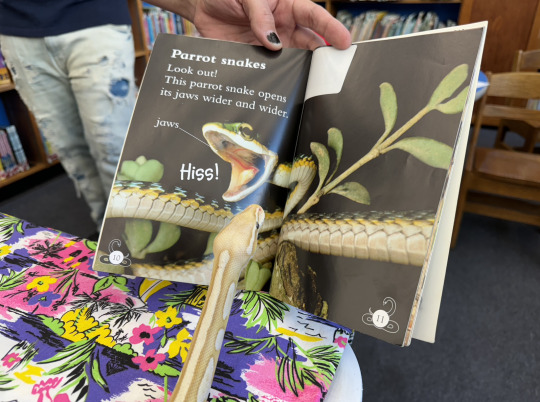
If you do a science event at a library and bring your snake, please be advised that someone might read a book to your snake.
1K notes
·
View notes
Note
are pycnofibers and feathers the same structure just diverged early on?
Short answer: Maybe, but really the question is kinda unanswerable currently
Long answer: The answer to this are built on not just one maybe, but multiple layers of maybes. To start with, in case anyone's unfamiliar, let's talk about analogous and homologous structures. In evolutionary biology, a physical feature is homologous if it is shared between two species, and the common ancestor of those two species also had that feature. A common example is that the arm of a human and the wing of a bird are homologous, because we share the same pattern of bones and our distant common ancestor had those same bones!
On the other hand, a physical feature is analogous if it has a shared function, and it may or may not share an evolutionary origin! So for example, a bat's wing and a bird's wing are both analogous (same function, powered flight) and homologous (same bone pattern shared with common ancestor). A bird's wing and a dragonfly's wing, however, are analogous, but are not homologous (they do not share an evolutionary origin).
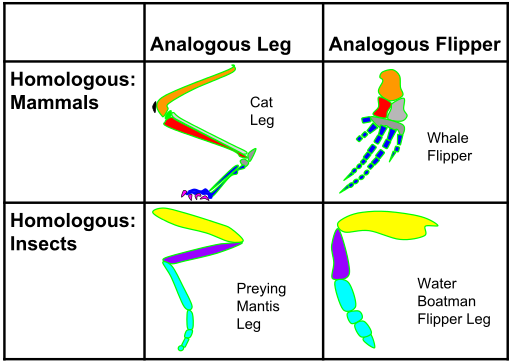
This table sums it up in a way that I find helpful, comparing analogous structures in insects and mammals. Via Wikimedia Commons.
So, the fuzz on dinosaurs and pterosaurs are pretty evidently analogous structures. They provide the same functions: temperature regulation, probably display, possibly smoothing the body's silhouette in flight? But the key question is, are they homologous? Did the common ancestor of pterosaurs and dinosaurs also have fuzzy structures?
Now, let's get to those multiple layers of maybes, starting with the issue of whether even dinosaurs had a fluffy common ancestor. We see evidence of filamentous structures in both theropods and ornithischians. These structures maybe come from the same evolutionary origin, and if they do, then the common ancestor of all dinosaurs right at the base of the tree also had filaments. As far as I'm aware, whether or not this is likely is a fairly subjective matter, but as you can probably tell from my palaeoart I lean towards the idea that dinosaurs were ancestrally fluffy.
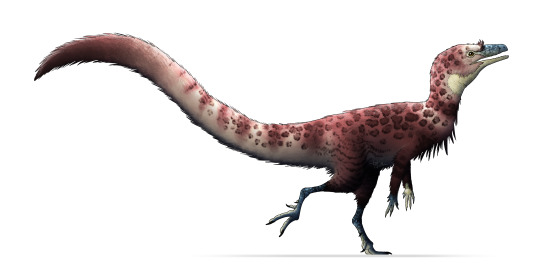
This little fellow, Lagerpeton, is one of the closest things to a dinosaur that isn't actually a dinosaur. If the ancestor of all dinosaurs was feathery, this guy probably was too!
If dinosaurs were ancestrally fluffy, then maybe the filaments of dinosaurs and pterosaurs come from the same evolutionary origin. If ancestral dinosaurs were fuzzy, that puts two very closely related lineages of fuzzy archosaurs very close together in time, some point in the Middle Triassic probably. If that's the case, then it makes sense that the common ancestor of these two groups was probably fuzzy.
However, you'll probably notice that this hypothetical scenario where ancestral fuzz is likely is constructed on top of the assumption that dinosaurs were ancestrally fuzzy, which is something that's still not fully proven. It's not even certain that all dinosaur fuzz is homologous, which makes pterosaurs tricky.
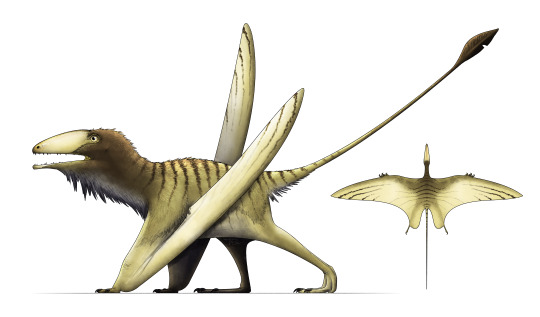
Even whether the earliest pterosaurs, like Peteinosaurus, had pycnofibres is currently only a matter of hypothesis!
The reality is the evidence which would most easily resolve the mystery currently does not exist. If, say, a Triassic dinosaur and Triassic pterosaur were discovered with fuzzy filaments then that would basically confirm that these two very close groups we both ancestrally fuzzy. Even better still would be some basal avemetatarsalian from the Middle Triassic with preserved fluff. That's basically like asking for the Holy Grail though, a genuine common ancestor of pterosaurs and dinosaurs.
Unfortunately, the oldest records we do have for feathered dinosaurs and pycnofibred pterosaurs stop at about the Middle Jurassic. Any older than that, and we lose the sites with immaculately fine silt grains that preserve soft tissue like feathers. That's not to say a future beautiful Middle Triassic silt bed couldn't show up, and oh boy I really hope one does eventually, but for now there's simply nothing out there to offer concrete proof.

Jeholopterus, an anurognathid pterosaur from the Middle to Late Jurassic of China, preserved with evidence of pycnofibres. Via Wikimedia Commons.
So in the absence of this proof, what do we do? I'd consider Occam's Razor a decent guiding principle here, although it's less reliable in some other areas of evolutionary biology. Occam's Razor basically states that the most reasonable explanation is one that doesn't unnecessarily multiply the entities of a problem.
To put it another way, it seems more reasonable, in an evolutionary sense, that three closely related groups (ornithischians, theropods, and pterosaurs) got their fuzziness from one fuzzy common ancestor. The alternate explanation is that two (or possibly three) very closely related groups all independently evolved remarkably similar feathery coats from being initially scaly.
Occam's Razor isn't foolproof, and there's a reason that we have the term convergent evolution, but in this case I think we should consider it a reasonable guess that the common ancestor of dinosaurs and pterosaurs had some sort of fluffy filaments, and that feathers and pycnofibres are indeed homologous.
But just to be clear, this is not the answer!! This is a best guess, a hypothesis based on available lines of evidence that disappear in the crucial stages of its evolutionary history, and the application of a logical rule of thumb to cap it off. Just because that's the side I lean towards, doesn't mean that the issue is settled or that I wouldn't change my perspective if new evidence came to light. That's the great thing about science after all!
So, I do hold to my original statement that right now, this question is not truly answerable (even though I've now spent almost 1000 words trying to answer it). We can guess and hypothesise, but for now the real answer remains out of reach.
#pterosaur#dinosaur#paleontology#paleoart#palaeoblr#science#science communication#long post#scicomm#prehistoric#fossils#feathers#feathered dinosaurs#biology#evolution#natural history
1K notes
·
View notes
Text

In May 2023, several whale watching operators in northeastern Japan were treated to multiple sightings of a white male killer whale.
White killer whales in Japan are rare but not unheard of—there seem to be at least 3 different individuals. Additionally, there are even more white killer whales documented in Russia!
The particular male seen in Japan in May 2023 bears a great resemblance to the famous Iceberg, a white Russian killer whale, but his saddle patches are slightly different. His pale skin is like a white canvas—every scratch and mark is easily visible, and even the algal accumulation on his skin is striking.
Nobody is sure what causes this white coloration. Russian researchers have suggested it may be albinism, but this has yet to be confirmed. Other conditions, such as leucism, can cause abnormally light coloration in animals.
#killer whale#orca#science communication#marine biology#marine mammal#whales#cetacean#cetaceans#marine mammals#orcas
532 notes
·
View notes
Text
#science#science communication#scicomm#stem#science education#science blog#biology#realtionship#animal behavior#Monogamy#relationship study
704 notes
·
View notes
Note
trick or treat! mayhaps featuring cephalopods?
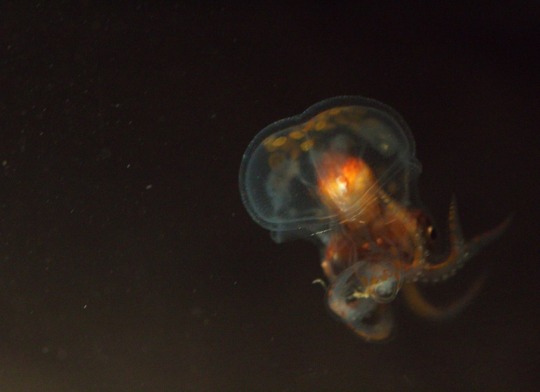
trick AND treat: This is a little paralarval giant pacific octopus I photographed back in 2021 named Hilda Doolittle (or maybe Emily Dickinson but I'm pretty sure its Hilda).
Though you can't see them, the outer surface of Hilda's body is covered in countless little chitinous tufts called Kölliker's organs, that she can puff out and retract. Eventually, she'd lose these little tufts before reaching adulthood. While scientists aren't yet certain of their purpose, Kölliker's organs have a huge impact on the surface area of paralarval octopus and may be used to leverage drag for more adept movement while the octopus is small. They estimate surface area is 2/3 greater when all Kölliker's organs are puffed out versus retracted.
#science facts#ask and i shall infodump#trick or treat#halloween#cephalopod#octopus#giant pacific octopus#Enteroctopus dolfeini#octopus paralarvae#Kolliker's organs#marine life#salish sea#my marine life photos#marine biology#science communication#my sci comm
62 notes
·
View notes
Note
Can I ask for a quick run down on what damage ark has done?
ark: survival evolved has countless prehistoric creatures inside of it that are not particularly well known. when people search for information on said critters, ark results are often the first to come up. the way the animals are portrayed in the game, in terms of physical appearance, are extremely inaccurate. designs from the game have been replicated and used by many people, including professionals (such as documentary makers), for their own designs, perpetuating that inaccurate idea. Heck, the Stephen Fry documentary has Ark dinos.
the inaccuracies aren't trivial, when we're depicting prehistoric animals people do not have a frame of reference to compare them to to understand what they were like. If you draw an elephant wrong, people can look up what an elephant looks like, or see one at the zoo. we don't have that for the dead.
Instead, you look up an image, and you see what's on google, which is often yet more inaccurate images. And suddenly, someone has a very skewed and incorrect view of prehistoric life
then on top of that, because the critters ark has aren't well known, sometimes ALL the results on google are just inaccurate depictions from ark
this has real consequences. as a docent, I had just as many people become extremely disappointed when I told them that ARK had it wrong as I did Jurassic World.
why does reality and accuracy matter? well
reality isn't going away, and we have to acknowledge that. you can't just create a new one. we have the one and only reality and its consequences to deal with. see: global warming happening literally right now
the idea that reality can be whatever you want it to be or that opinions matter when it comes to facts is exactly how politicians and other people who desire control manipulate people. see the "fake news" phenomenon
people ignoring reality and how it functions leads to a variety of extremely bad things, including cults, hate groups, and - once again - global fucking warming
as such, anything that makes it seem like reality is more murky than we know - such as filling a google images result section with inaccurate portrayals - makes people question the fact that reality is, actually, unmoveable
in this case, birds being living dinosaurs and dinosaurs being portrayed accurately is extremely important for people to know because it demonstrates that humans are not actually the "main character" of planet earth, and we have to stop acting like it (there is no main character)
why do we have to stop acting like it? well, for one, the extreme amounts of destruction we've caused on this planet. for two, because we can go extinct, we operate under the same rules as all life (one such rule is more diversity = more chances for survival), and we have to stop clowning around and arguing about shit that doesn't matter and actually focus on repairing the harm that we have done to the planet and to each other
so yeah. that's why accuracy in paleomedia matters.
because reality matters.
and reality isn't up for debate.
p. s. I don't care that it's a fictional game that says its fictional, if people are coming to me with misconceptions from a thing and thinking they're real, then that thing has fucked up. end of story. and I had *so many* ark fans come to me at the Field Museum. so many.
371 notes
·
View notes